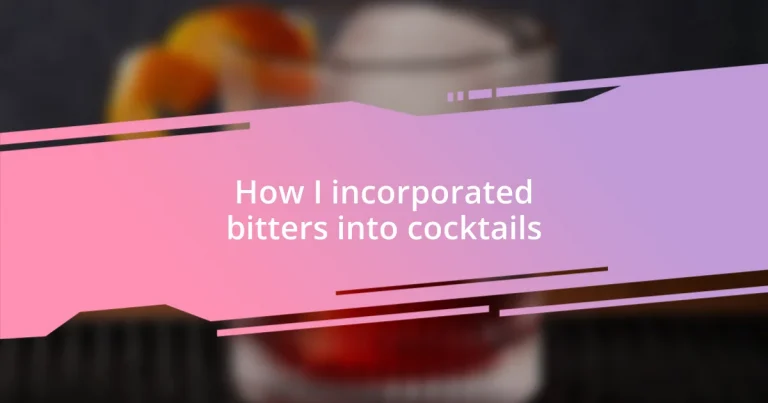Key takeaways:
- Bitters enhance the complexity and balance of cocktails, acting as essential flavor components similar to seasoning in food.
- Various types of bitters (e.g., Angostura, orange, grapefruit, chocolate) offer distinct flavors for cocktail experimentation and creativity.
- Techniques like layering, rinsing, and garnishing with bitters can significantly elevate the cocktail experience, both in flavor and presentation.

Understanding bitters in cocktails
Bitters are often described as the seasoning of cocktails, and I can’t help but agree. Just think about it: a cocktail without bitters can feel flat and one-dimensional, much like a meal lacking salt. I remember the first time I added orange bitters to a classic Manhattan; it transformed the drink completely, adding depth and a subtle complexity that made my taste buds dance.
When I first delved into the world of bitters, I was amazed by the sheer variety available. From aromatic to herbal and even fruity, each type brings its unique essence to the mix. Have you ever wondered how just a few dashes can elevate a drink? I experimented with grapefruit bitters in a gin and tonic once, and the refreshing twist caught everyone off guard. It opened my eyes to the artistry involved in crafting cocktails.
Understanding bitters goes beyond just mixing them in; it’s about recognizing their role in balancing flavors. I often think of cocktails as symphonies, and bitters are like the conductor guiding each note to harmonize beautifully. Have you ever tasted a cocktail where a bitter note cut through the sweetness in just the right way? That’s where the magic happens. Every sip tells a story, and I find that bitters are often the unsung heroes behind those narratives.

Types of bitters to explore
When diving into the world of bitters, I discovered a few distinct types that truly stand out. Each type has a personality of its own, influencing the cocktails in fascinating ways. For instance, one night, I decided to create a unique twist on an old classic by using chocolate bitters. The result was nothing short of magical, adding a rich and unexpected layer that left my friends pondering the flavor for hours.
Here are some types of bitters worth exploring:
- Angostura Bitters: A must-have in every bar. Its aromatic blend pairs well with most cocktails.
- Orange Bitters: Perfect for cocktails like the Martini or Manhattan, adding a zesty flair.
- Peychaud’s Bitters: With a lovely anise flavor, it’s essential for a proper Sazerac.
- Aromatic Bitters: These come in various brands and often add depth to whiskey-based drinks.
- Grapefruit Bitters: A bright, refreshing choice that wonderfully complements gin cocktails.
- Chocolate Bitters: Great for dessert cocktails or to add a unique twist to classics.
In my journey, I’ve also stumbled upon delightful craft bitters, which can elevate a cocktail to an art form. One evening, I played around with lavender bitters, and the floral notes paired beautifully with gin, turning a standard drink into a calming experience. These little bottles are bursting with potential, and if you’re willing to experiment, you might just find your new favorite flavor.

Techniques for incorporating bitters
Incorporating bitters into cocktails can be a bit of an art form, and I’ve learned a few techniques that can truly elevate your drinks. One method I favor is the “layering” technique, where I add different types of bitters at various stages of mixing. For instance, when making an Old Fashioned, I start with Angostura bitters for depth and follow it with a touch of orange bitters at the end. This not only creates complexity but invites the drinker on a little journey with each sip. Have you ever noticed how flavors can unfold as you drink? That’s the beauty of layering.
Another technique worth trying is the “rinse” method, which involves coating the inside of the glass with bitters before pouring the cocktail. One evening, I whimsically rinsed a coupe glass with absinthe bitters before pouring in a classic martini. The result was delightful—the bitters clung to the glass, releasing their aromatic essence and adding a subtle hint that played beautifully with the gin. It’s a simple trick, yet it truly captivates the senses and elevates the overall experience.
Lastly, don’t underestimate the power of bitters in garnishes. Adding a twist of citrus peel and a dash of aromatic bitters on top can transform not just the flavor profile but also the visual appeal of your cocktail. I remember experimenting with a whiskey sour by finishing it with a splash of chocolate bitters and a bright lemon twist. The color contrast and the aroma created an inviting drink that was hard to resist. So, don’t shy away from these techniques; they can offer a new perspective on your cocktail creations!
| Technique | Description |
|---|---|
| Layering | Adds different bitters at various stages to create complexity. |
| Rinse | Coat the glass with bitters before pouring for a subtle flavor enhancement. |
| Garnishing | Top with bitters and a citrus twist for visual appeal and aroma. |

Signature cocktails with bitters
When I think of signature cocktails with bitters, a classic Negroni immediately comes to mind. The deep, herbal notes from both sweet vermouth and Campari blend wonderfully with just a dash of orange bitters. I remember the first time I sipped it; the complexity was intoxicating! It’s like a symphony of flavors playing together, making each moment of sipping a delightful experience.
Then there’s the Peychaud’s Bitters Sazerac, which I became obsessed with after a trip to New Orleans. The combination of rye whiskey, a sugar cube, and a rinse of absinthe brings an intriguing twist, but what truly makes it shine is the addition of Peychaud’s bitters. It’s fascinating how a single ingredient can instantly transport a drink—and me—into a different world. I felt like I was sitting in a lively bar on Bourbon Street, soaking in the vibrant atmosphere.
Another gem I’ve discovered is the Chocolate Mint Mojito. Adding chocolate bitters to this classic cocktail brought an unexpected richness that I never anticipated. It was a warm summer evening, and as I served it to friends, I watched their eyes light up with surprise. The refreshing mint complemented the chocolate, creating a unique drink that left everyone wanting a second round. Have you ever been amazed by how one small change can redefine a beloved recipe? That’s the magic of bitters, and it’s an adventure I wholeheartedly encourage you to embark upon.

Tips for balancing flavors
Balancing flavors in cocktails can sometimes feel like a puzzle, but it’s one that I’ve learned to enjoy solving. When I’m experimenting, I often focus on the ratio of sweet to bitter. For instance, in a Manhattan, if the sweet vermouth is too prominent, I’ll add a couple of dashes of aromatic bitters. It’s amazing how those small adjustments can harmonize the drink, turning it from a basic cocktail into something truly refined. Have you ever played with sweetness in a cocktail? It can really transform your whole experience.
Another vital aspect is considering the intensity of your bitters. I like to think of bitters as seasoning; just like salt, a little can go a long way. When I made a bold mezcal cocktail recently, I hesitated but decided to add only a drop of smoked bitters. The result was an exhilarating kick that didn’t overpower the other flavors, like a gentle reminder of the smoky background. Have you ever found that balancing bold flavors can be a bit tricky? In those moments, I remind myself to trust my intuition and taste along the way.
Finally, remember that the balance of flavors isn’t just about taste—it’s also about aroma. I love crafting cocktails that tell a story through their scent. When I prepare a refreshing gin fizz, I’ll finish it off with a spritz of orange bitters. That delightful aroma wafting up right before the first sip heightens my anticipation. Have you ever noticed how the smell can amplify your enjoyment? It’s like setting the stage for the taste, making the cocktail experience all the more captivating.

Experimenting with bitters at home
Experimenting with bitters at home has become a delightful hobby for me. The first time I decided to play around with lavender bitters, I mixed them into a simple gin and tonic. I was pleasantly surprised at how the floral notes blended beautifully with the gin’s botanicals, transforming an everyday drink into something extraordinary. Have you ever had that moment when a change in an ingredient unlocks a new dimension of flavor?
I remember one gray, rainy afternoon when I decided to try my hand at making a bourbon cocktail with a few drops of orange bitters. The warmth from the bourbon, combined with the bright citrus notes, lifted my spirits like sunshine breaking through clouds. This experience reminded me that bitters aren’t just for cocktails—they can evoke emotions and memories. Isn’t it interesting how a single drop can change the mood of a drink?
As I continue to experiment, I love inviting friends over for a “bitters tasting night.” It’s not only fun to share my creations but also to witness their reactions. One memorable evening, I introduced peach bitters into a sweet tea cocktail, and the room erupted in delight. That sense of excitement and discovery is what keeps me experimenting with bitters. Have you ever shared a unique sipping experience and found it brought people closer? That’s the power of cocktails with a twist!














